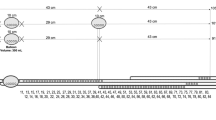Abstract
PURPOSE: This study was designed to evaluate the relationship between internal sphincter electromyographic frequency and ambulatory anal pressures in order to clarify the pathophysiology of internal anal sphincter dysfunction in fecal incontinence. METHODS: Seventytwo patients of median age 55 years (range, 24–75; 63 females) with neurogenic fecal incontinence and 33 normal subjects of median age 48.5 years (range, 25–74; 21 females) underwent fine-wire anal sphincter electromyography and anal manometry. RESULTS: The median internal anal sphincter electromyographic frequency was incontinent 0.25 Hz (0.2–0.34) and the control was 0.44 Hz (0.36–0.55;P<0.03). Ambulatory resting pressures were incontinent median 54 cm of H 2 O (34–68 cm of H 2 O) and control 94 cm of H 2 O (72–102;P<0.01). Internal sphincter electromyographic frequency correlated with anal resting pressures in both groups (P<0.002). Internal sphincter electromyographic silence not attributable to electrode movement or the rectoanal inhibitory reflex, lasting 0.5 to 4 minutes occurred in all but two of the incontinent patients. The anal pressure during this period did not significantly change (P>0.1). No recruitment of the external sphincter or puborectalis was noted during these episodes. Such electromechanical dissociation was not seen in the control group. The frequency of transient internal sphincter relaxation was 4 (ranges 2–6) per hour in controls and 8 (ranges, 6–12) per hour in incontinent patients (P<0.01). Rectal pressures did not exceed midanal pressures in any of the controls but did in all of the incontinent patients on at least one occasion per hour in the incontinent group. CONCLUSION: Internal anal sphincter activity exhibits electromechanical dissociation and relaxes abnormally in incontinent patients.
Similar content being viewed by others
References
Duthie GS, Miller R, Bartolo DC. Internal anal sphincter electromyographic frequency is related to anal canal resting pressure. Both are reduced in idiopathic faecal incontinence. Gut 1990;31:A619.
Browning GG, Parks AG. Postnatal repair for neuropathic faecal incontinence: correlation of clinical result and anal pressures. Br J Surg 1983;70:101–4.
McHugh SM, Diamant NE. Effect of age, gender, and parity on anal canal pressures. Contribution of impaired anal sphincter function to faecal incontinence. Dig Dis Sci 1987;732:726–36.
Read NW, Harford WV, Schmulen AC,et al. A clinical study of patients with fecal incontinence and diarrhea. Gastroenterology 1979;76:747–56.
Womack NR, Morrison JF, Williams NS. The role of pelvic floor denervation in the aetiology of idiopathic faecal incontinence. Br J Surg 1986;73: 404–7.
Bartolo DC, Jarratt JA, Read MG, Donnelly TC, Read NW. The role of partial denervation of the puborectalis muscle in idiopathic faecal incontinence. Br J Surg 1983;70:664–7.
Swash M, Gray A, Lubowski DZ, Nicholls RJ. Ultrastructural changes in internal anal sphincter in neurogenic faecal incontinence. Gut 1988;29:1692–8.
Lubowski DZ, Nicholls RJ, Burleigh DE, Swash M. Internal anal sphincter function in neurogenic fecal incontinence. Gastroenterology 1988;95:997–1002.
Kerremans R. Morphological and physiological aspects of anal continence and defaecation. Brussels: Edition Arscia, 1968.
Pennickx F. Morphological and physiological aspects of anal function. Leuven:Acco n.v., 1981.
Bouvier M, Gonella J. Nervous control of the internal anal sphincter of the cat. J Physiol (Lond) 1981;310:457–69.
Monges H, Salducci J, Naudy B, Ranieri F, Gonella J, Bouvier M. The electrical activity of the internal anal sphincter: a comparative study in man and in cats. In: Christensen J, ed. Gastrointestinal motility. New York: Raven Press, 1980:495–501.
Duthie HL. Anal continence. Gut 1971;12:844–52.
Miller R, Lewis GT, Bartolo DC, Cervero F, Morten-sen NJ. Sensory discrimination and dynamic activity in the anorectum: evidence using a new ambulatory technique. Br J Surg 1988;75:1003–7.
Sun WM, Read NW, Miner PB, Kerrigan DD, Donnelly TC. The role of transient internal sphincter relaxation in faecal incontinence? Int J Colorectal Dis 1990;5:31–6.
Frenckner B, von Euler C. Influence of pudendal nerve block on the function of the anal sphincters. Gut 1975;16:482–9.
Snooks SJ, Barnes RP, Swash M. Damage to the voluntary and urinary sphincter musculature in incontinence. J Neuro Neurosurg Psych 1984;47: 1269–73.
Snooks SJ, Swash M, Henry MM, Setchell M. Risk factors in childbirth causing damage to the pelvic floor innervation: a precursor to stress incontinence. Int J Colorectal Dis 1986;1:20–4.
Burnett SJ, Spence-Jones C, Speakman CT, Kamm MA, Hudson CN, Bartram CI. Unsuspected sphincter damage following childbirth revealed by endoanal endosonography. Br J Radiol 1991;64:225–7.
Snooks SJ, Setchell M, Swash M, Henry MM. Injury to the innervation of the pelvic floor musculature in childbirth. Lancet 1900;2:546–50.
Read NW, Haynes WG, Bartolo DC,et al. Use of anorectal manometry during rectal infusion of saline to investigate sphincter function in incontinent patients. Gastroenterology 1983;85:105–13.
Author information
Authors and Affiliations
Additional information
Supported by a separate equipment grant from the Scottish Hospital Endowment Research Trust.
Read at the meeting of The American Society of Colon and Rectal Surgeons, San Francisco, California, June 7 to 12, 1992.
About this article
Cite this article
Farouk, R., Duthie, G.S., MacGregor, A.B. et al. Evidence of electromechanical dissociation of the internal anal sphincter in idiopathic fecal incontinence. Dis Colon Rectum 37, 595–601 (1994). https://doi.org/10.1007/BF02050996
Issue Date:
DOI: https://doi.org/10.1007/BF02050996




